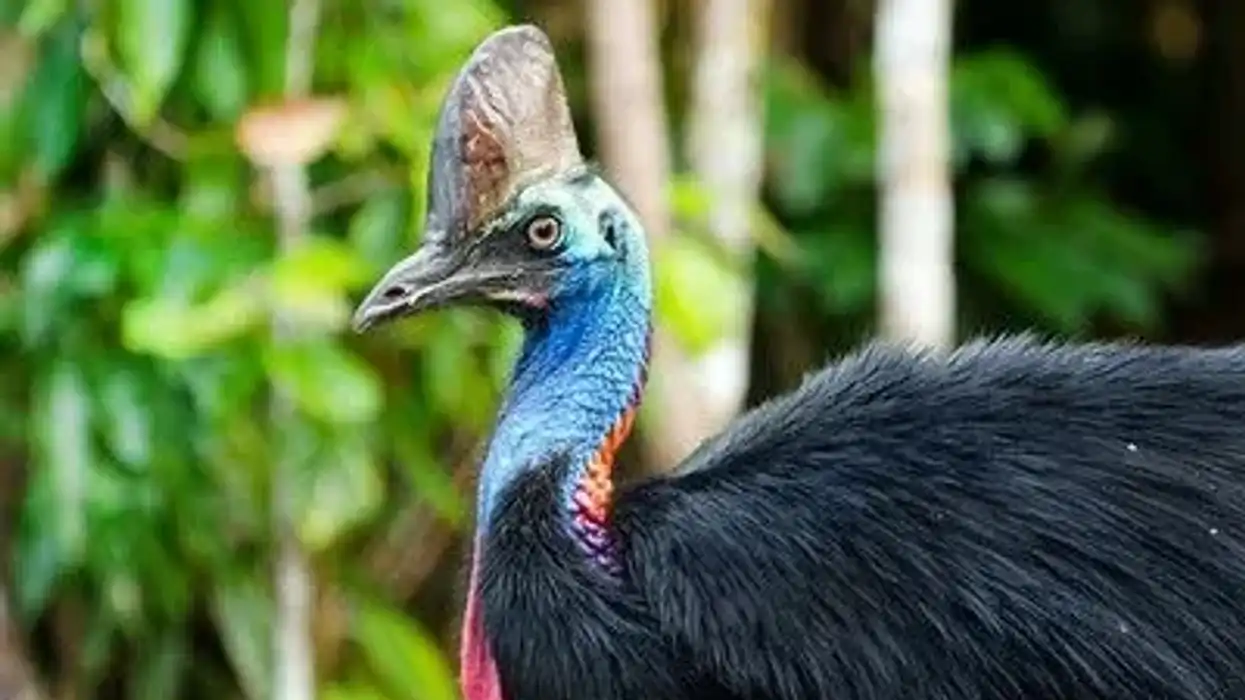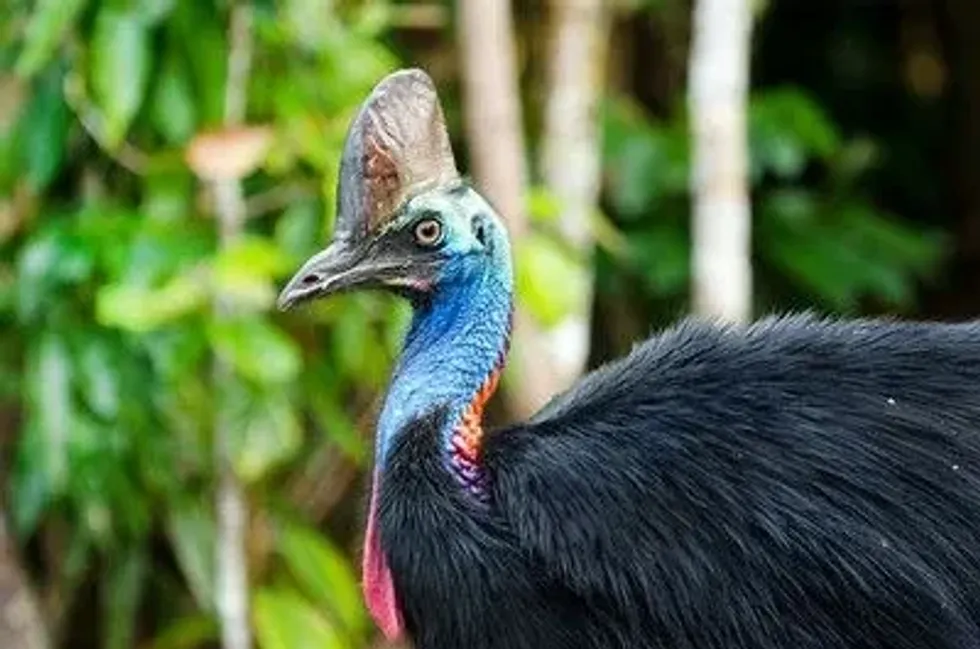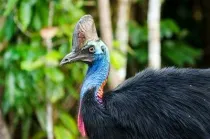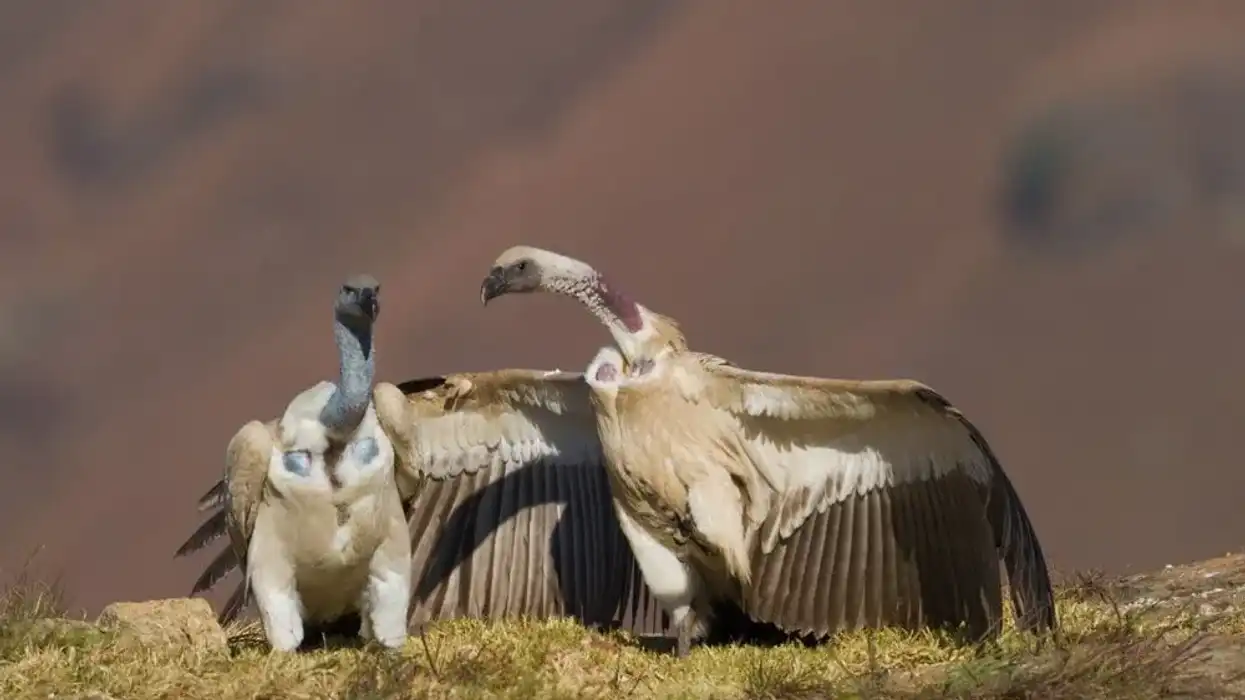Fun Southern Cassowary Facts For Kids

Have you heard of one of the world's most dangerous birds? Along with the ostrich and emu, the southern cassowary (Casuarius casuarius) is considered to be a dangerous bird. So, why are they dangerous?
What do they look like? What is their food? Read this article to know all about southern cassowaries and to find the answers to these questions!
Southern cassowaries are enormous, colorful, and vicious birds with powerful gray-colored legs, and soft, shining feathers on their body and tail. Amazingly, their skin color changes with the mood swings of the southern cassowary (Casuarius casuarius).
They have a blue, torque-colored long neck and helmet-like casque on top of their head, three-toed feet, and enough powerful energy to attack viciously. Its feet are used to kick its enemies and its casque skin is not as hard as it looks, but it grows with age.
Interestingly, females have a bigger casque than males.
The Australian cassowaries are one of the world's tallest birds with a healthy weight. The habitats of these birds are rainforests, woodlands, and mangroves found in Australia, New Guinea, and Indonesia.
For further details about these fantastic creatures, read through this article. If learning about animals amazes you, check out our guide to the ostrich and crowned eagle too!
Southern Cassowary Interesting Facts
What type of animal is a southern cassowary?
The southern cassowary (Casuarius casuarius) is also known as the two-wattled cassowary or the southern double wattled cassowary. It is a bird with a vast structure and red-colored wattles hanging down from its neck, with sharp three-toed feet.
What class of animal does a southern cassowary belong to?
Like many birds and reptiles, southern cassowaries belong to the Aves class. They are considered to be the biggest Australian bird.
How many southern cassowaries are there in the world?
Sadly, the number of southern cassowaries in the world is reducing day by day. They are primarily found in Queensland in Australia, New Guinea, and Indonesia. In 2014, reports in Australia counted just 4,000 of these flightless birds.
Where does a southern cassowary live?
Many of these double-wattled cassowaries live in tropical rainforests in Queensland. They also like to stay in places near beaches, woodlands, and mangroves.
As they depend primarily on different types of fruit and plants for food, they build shelters in mixed environments where finding food is less of a problem. More generally, we find these powerful birds in Australia, Indonesia, and Papua New Guinea.
What is a southern cassowary's habitat?
The habitats of southern cassowaries are in the rainforest, Melaleuca swamps, and mangrove forests. They depend mostly on fallen fruit found on the forest floor and hence choose locations where food is abundant. Cassowaries are sometimes called seed carriers because they carry seeds from trees and plants in the rainforest from one place to another.
Who do southern cassowaries live with?
Southern cassowaries like to live alone. These solitary animals create a large home in dense forests, so it is normal for these birds to stay away from one another. Only during the breeding season, do cassowaries come into contact with each other.
How long does a southern cassowary live?
Along with ostriches, the cassowaries are considered among the most dangerous birds globally. A southern cassowary lifespan averages between 40-60 years. But deforestation, road kills, and clearing of lands is leading to the decline of cassowaries.
How do they reproduce?
The breeding season starts between May and June. Female cassowary birds follow the polygynandry method, mating with more than one male partner during each breeding season, so each female lays between three and eight eggs.
Southern cassowary eggs are laid in different colors like bright green and pale green-blue eggs. Do you know any other birds that lay such colorful eggs?
By laying these green eggs, the female bird's job is complete, and males take up the responsibility for incubating the eggs for approximately 50 days.
They add and remove litter to these eggs in order to regulate the temperature, and, once hatched, they protect their little birds from dogs, humans, and other predators for nine months, as well as provide them with food and water. The father cassowary will not leave the young chicks even to meet his own basic needs.
What is their conservation status?
The southern cassowary bird is considered endangered in Queensland. But, the IUCN (International Union for Conservation of Nature) has changed these birds' conservation status from Vulnerable to of Least Concern recently.
The reasons for the decrease in this species' population are road kills, clearing of lands, and threats from feral pigs and dogs. If the large-scale destruction of forests is stopped, we have a better chance of saving these species.
Southern Cassowary Fun Facts
What do southern cassowaries look like?
Southern cassowaries are giant birds with a neck that is bent downwards, a helmet-like casque on its head, two red wattles hanging down from the neck, a sharp beak, and powerful legs. Their long feet have only three toes. Their bodies are a jet black color with their neck and head covered in blue and violet color combinations.

How cute are they?
Cassowaries are flightless birds with sharp claws, a very large body, and powerful legs. If we ignore their aggression, these birds can be considered cute. They have a blue-colored long neck and bright red wattles.
Their feathers resemble a thick fur blanket, with a casque on its head that grows with age. Therefore, this colorful bird is very cute in appearance. These solitary animals are a feast for the eyes, but they are ranked as one of the most dangerous species in the world!
How do they communicate?
Southern cassowaries stay in the dense tropical rainforest so the frequency of the southern cassowary call is very low and quiet. The sounds that they make are called booms. While making this sound, they try to bend their head down to the ground.
Their casque also plays a vital role in the sound resonating. They communicate only during the breeding season or when detecting dangers. Some people say that their sound resembles that of a growling mammal.
How big is a southern cassowary?
The southern cassowaries (also known as the Casuarius casuarius johnsonii) are massive birds with long bent necks and a helmet on their head called a casque. The average southern cassowary height is 5.5 ft (200 cm), as tall as some humans.
Male cassowaries weigh 121 lb (55 kg), and females weigh 167 lb (76 kg). The southern cassowary is approximately 50 times bigger than the hummingbird.
Can a southern cassowary fly?
Southern cassowaries cannot fly. This giant bird that resembles a dinosaur has soft, black feathers on its body and these birds belong to the Ratites group. In this group, birds have heavy feathers and flat breast bones. Their muscles don't support flying.
How much does a southern cassowary weigh?
The southern cassowary is the third heaviest Australian bird. The female cassowaries are heavier than the males.
Female cassowaries weigh 167 lb (76 kg) and male cassowaries weigh around 121 lb (55 kg). The weight of any individual bird depends on its food intake. Cassowaries mainly eat fruits and small vertebrates like tiny fish and frogs, fungi, and different species of plants.
What are their male and female names of the species?
There is no particular name for the cassowaries' female and male birds. The females are simply called female cassowaries, and the males are called male cassowaries. A group of cassowaries is called a shock.
What would you call a baby southern cassowary?
The babies of southern cassowary birds are called chicks. Unlike its mother, a baby cassowary will have stripes all over its body. They leave their father cassowaries after nine months and learn to become independent cassowaries.
What do they eat?
Is the southern cassowary omnivore? Yes, the southern cassowary's diet consists mainly of fallen fruits on the forest grounds and small vertebrates. They also eat fungi, plants, seeds, and invertebrates.
During hot seasons, cassowaries drink water by bending their head down and then lifting it to swallow. They swallow any fruit as a whole. They also often try to eat their poop for absorbing the remaining nutrients from undigested fruits.
Are they loud?
No, the southern double-wattled cassowaries are not at all loud. They make low-frequency sounds during the breeding season to attract mates or to attack enemies. These rumbling and booming sounds are very low in frequency.
Would they make good pets?
The southern cassowary (Casuarius casuarius) is considered one of the most dangerous birds in the world. Though they are colorful with adorable looks, they are not good pets. These wildlife species like to spend time in solitude and they can become aggressive when threatened.
A southern cassowary attack can be very dangerous. They use their claws to attack their predators, and once a cassowary has even killed a human! The southern cassowaries kill predators quickly, using their sharp claws.
Did you know...
The southern cassowary kick can be lethal. These birds don't like human interference in their lives and they don't want to be disturbed and provoked.
Southern cassowaries have hidden spikes in their wings, but even these dangerous birds have predators, including crocodiles, dogs, and humans. Their eggs are green in color.
This green color is thanks to the pigment present in their eggshells. This color helps to protect the eggs from southern cassowary birds' predators in the rainforest. The male southern cassowary plays a vital role in his chicks' growth beyond the initial breeding season.
As they live in dense forests, these birds adapt to the environment, nature, and climate of the forests. Just one of many southern cassowary adaptations is that their fur-based feathers protect them from thorns and spikes present in their surroundings.
Though they cannot fly, these animals are experts in swimming and sprinting.
Why is the cassowary so dangerous?
Cassowaries are considered to be dangerous flightless birds. When provoked by humans or enemies, the southern cassowary attacks them with its claws.
Like ostriches and emus, they have very sharp, knife-shaped talons and, as we know, they are great sprinters. The southern cassowary attacks at a speed of 30 mph (48 kph), and with the help of their sharp nails, they scratch upwards and downwards on their enemies.
They need to be handled with great care, as they won't attack anyone without reason.
Why is the southern cassowary endangered?
The southern cassowary is not listed as Endangered on the ICUN red list, but their number reduces day by day. The numbers are reducing for many reasons.
Road kills and land clearings are among the main reasons for the decreasing numbers of this species. They are an essential species to the environment because they are seed carriers that carry seeds of different fruits from one place to another.
In doing this, they help to promote the growth of dense forests. To save these valuable species, the Australian government has taken some measures, including growing different plant species in the rainforest to encourage biodiversity.
Here at Kidadl, we have carefully created lots of interesting family-friendly animal facts for everyone to discover! Learn more about some other birds including the great green macaw, or Fischer's lovebird.
You can even occupy yourself at home by drawing one on our southern cassowary coloring pages.
We Want Your Photos!
More for You
See All
Doctorate specializing in Veterinary Medicine

Oluniyi AkandeDoctorate specializing in Veterinary Medicine
With an accomplished background as a Veterinarian, SEO content writer, and public speaker, Oluniyi brings a wealth of skills and experience to his work. Holding a Doctor of Veterinary Medicine degree from the University of Ibadan, he provides exceptional consulting services to pet owners, animal farms, and agricultural establishments. Oluniyi's impressive writing career spans over five years, during which he has produced over 5000 high-quality short- and long-form pieces of content. His versatility shines through as he tackles a diverse array of topics, including pets, real estate, sports, games, technology, landscaping, healthcare, cosmetics, personal loans, debt management, construction, and agriculture.
Bachelor of Arts specializing in Political Science and Sociology

Spandana KantamBachelor of Arts specializing in Political Science and Sociology
Spandana holds a Bachelor's degree in Political Science from Acharya Nagarjuna University. She has a passion for writing and enjoys reading crime and thriller novels while listening to RnB music in her free time.
Disclaimer
1) Kidadl is independent and to make our service free to you the reader we are supported by advertising. We hope you love our recommendations for products and services! What we suggest is selected independently by the Kidadl team. If you purchase using the Buy Now button we may earn a small commission. This does not influence our choices. Prices are correct and items are available at the time the article was published but we cannot guarantee that on the time of reading. Please note that Kidadl is a participant in the Amazon Services LLC Associates Program, an affiliate advertising program designed to provide a means for sites to earn advertising fees by advertising and linking to Amazon. We also link to other websites, but are not responsible for their content.
2) At Kidadl, we strive to recommend the very best activities and events. We will always aim to give you accurate information at the date of publication - however, information does change, so it’s important you do your own research, double-check and make the decision that is right for your family. We recognise that not all activities and ideas are appropriate for all children and families or in all circumstances. Our recommended activities are based on age but these are a guide. We recommend that these ideas are used as inspiration, that ideas are undertaken with appropriate adult supervision, and that each adult uses their own discretion and knowledge of their children to consider the safety and suitability. Kidadl cannot accept liability for the execution of these ideas, and parental supervision is advised at all times, as safety is paramount. Anyone using the information provided by Kidadl does so at their own risk and we can not accept liability if things go wrong.
3) Because we are an educational resource, we have quotes and facts about a range of historical and modern figures. We do not endorse the actions of or rhetoric of all the people included in these collections, but we think they are important for growing minds to learn about under the guidance of parents or guardians.







